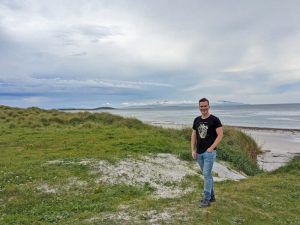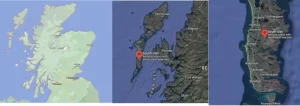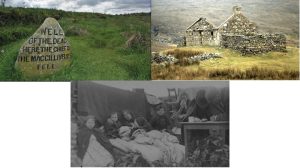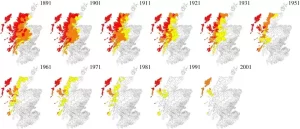The following article was written by Paul Meighan and was first posted on bella caledonia.
LANGUAGES DO NOT “DIE”, THEY ARE PERSECUTED: A SCOTTISH GAEL’S PERSPECTIVE ON LANGUAGE “LOSS”

Two-thirds of the world’s 7000-7500 languages are Indigenous languages. One-third of Indigenous languages are experiencing language loss and “as many as 90% are predicted to fall silent by the end of the century” (McCarty, 2018, p. 23). However, languages do not simply “die”, nor do they magically disappear. All languages change over time, but language shift, endangerment, or “death” is not natural nor is it unavoidable.
Languages are endangered and threatened due to inequitable sociopolitical structures and deliberate processes of oppression, discrimination, and violence. In this BILD blog post, I will illustrate some of the causes of Gàidhlig (Scottish Gaelic) language endangerment. Gàidhlig is an endangered Indigenous language in Alba (Scotland) with approximately 57,000 speakers, around 1% of the Scottish population.
Is mise Pòl Miadhachàin-Chiblow. ’S e Gàidheal a th’ annam. Rugadh agus thogadh mi ann an Glaschu, Alba. My name is Paul Meighan-Chiblow. I’m a Scottish Gael. I was born and raised in Glasgow, Scotland. I am in the process of reclaiming Gàidhlig, my familial language, as an adult learner.
My worldview and experiences as a Gàidheal (Scottish Gael) growing up in Glaschu (Glasgow) inform my research and work as a critical sociolinguist. I was raised by my mother, Angusina MacGillivray, who is from the Gàidhealtachd, more specifically, Dalabrog (Daliburgh), in the northwestern island of Uibhist a Deas (South Uist) in na h-Eileanean Siar (Western Isles) (Figure 1). The Gàidhealtachd is comprised of the Gaelic-speaking areas of Scotland, also known as the Highlands and Islands of Scotland. Uibhist a Deas is one of the heartlands of the now endangered Gàidhlig with some of the strongest Gàidhlig-speaking communities in the world, ranging from 62% to 79% of the respective community populations.

I would hear Gàidhlig (Scottish Gaelic) all the time around my fluent speaking grandmother, Dolina Walker, who moved the family to Glaschu for work reasons when my mother was a teenager, and who lived down the street from us. However, Gàidhlig was not available to me in school. I did not understand why at the time, but now as an adult learner of Gàidhlig I do. Gàidhlig and Gaelic culture were almost eradicated due to many factors, such as the forced eviction of the Gàidheil (Gaels) from their traditional homes and lands during the Highland Clearances in the mid-18th to -19th centuries and the destruction of centuries-old Gaelic clan-based society after the Battle of Culloden in 1746 by British government and imperial forces (MacKinnon, 2017). Patrick Sellar in 1816 described Gàidhlig as the “barbarous jargon of the times when Europe was possessed by savages”, and John Pinkerton wrote of the Scottish Gaels in 1794 (quotes found in MacKinnon, 2017, pp. 35-38):
Had all these Celtic cattle emigrated five centuries ago, how happy had it been for the country! All we can do now is plant colonies among them; and by this, and encouraging their emigration, try to get rid of the breed.

Figure 2: Battle of Culloden site showing where MacGillivray Chief fell; Abandoned croft; Eviction scene at Lochmaddy, North Uist.
The Education (Scotland) Act of 1872 made school attendance compulsory with zero provision for Gàidhlig. Education and English became synonymous. The educational system transmitted to Gaels and Gaelic speakers a colonized mentality and an internalized deficit ideology, such as “a deep and subtle feeling that English must be superior to Gaelic” (Smith, 1982). In more recent times, members of my family and older generations recall physical as well as mental violence, such as being beaten for speaking the language in classrooms. An example is the maide crochaidh (the “hanging” or “punishment” stick) that children passed along to those who were caught speaking Gàidhlig (MacKinnon, 2019). Moreover, Gàidhlig, spoken for more than 1500 years in Alba, is still not recognized as an “official language” in the United Kingdom, despite Gàidhlig and Gaelic culture predating the formation of the British state.The multigenerational and psychological impacts of the trauma associated with the oppression and repression of Gàidhlig and Gaelic culture linger to this day and have been driving factors for language shift, “loss”, socioeconomic and sociopolitical inequities, and the near destruction of family and community intergenerational language transmission in Alba (see the diminishing numbers of Gàidhlig speakers in Figure 3 below). McFadyen and Sandilands (2021) elaborate,
The ongoing legacy of this coloniality of power is destructive in a myriad of ways. In the Gàidhealtachd the effects of clearance are still felt, with a fragile economy, rural housing crisis and the decline of the Gaelic language. In his essay, Real People in a Real Place, Iain Crichton Smith spoke of historical ‘interior colonisation’ alongside a growing materialism which, he believed, had left Gaels in a cultural milieu increasingly ‘empty and without substance’ …such a view resonates with…perspectives made by writers and scholars of indigenous peoples across the globe. This is not to suggest or promote an equivalence here between the experience of the descendants of enslaved people and others who experienced colonisation by modern, imperial states; rather, such perspectives describe symptoms of human-ecological disconnect, alienation and loss of meaning – an indicator of just how far our human psyche and culture has become divorced from our natural environments (p. 163).

Joseph Murphy (2009) writes,
It is widely accepted that Gaelic people in Ireland and Scotland have been through a colonial experience. Indeed, Gaels were amongst the first to experience colonialism and many of the policies and processes which would later become synonymous with it emerged in this context first. Although it is unrealistic to identify a series of steps or stages of colonialism it is possible to identify key characteristics or moments, such as the undermining of indigenous institutions, cultural stereotyping, and physical occupation…The replacement of existing governing institutions, negative cultural stereotypes, and the extension of formal control over Gaelic territory cleared the way for the full range of ‘ethnocidal policies’ (p. 24).
And Sorley MacLean, renowned Scottish Gaelic poet, talks about historical whitewashing in the 1974 documentary Sorley MacLean’s Island (extract plays from 2:34-3:34):
Ever since I was a boy in Raasay and became aware of the differences between the history I read in books and the oral accounts I heard around me, I have been very sceptical of what might be called received history; the million people for instance who died in Ireland in the nineteenth century; the million more who had to emigrate; the thousands of families forced from their homes in the Highlands and Islands. Why was all that? Famine? Overpopulation? Improvement? The Industrial Revolution? Expansion overseas? You see, not many of these people understood such words — they knew only Gaelic. But we know now another set of words: clearance, empire, profit, exploitation; and today we live with the bitter legacy of that kind of history.
As a direct result of deliberate processes of covert and overt linguistic eradication, family land dispossession, the role of the educational system, and internalized deficit ideologies about the “value” of Gàidhlig, I do not speak my language fluently yet. I am currently on a language reclamation journey as an adult learner since I refuse to be, as the Scottish Gaelic writer Iain Crichton Smith (1982) writes in Towards the Human, “colonised completely at the centre of the spirit” (p. 70).
As this short blog post demonstrates, languages do not just “die”. Rather, language speakers, cultures, and communities are deliberately persecuted, oppressed, and minoritized,either overtly or covertly. To this day, attitudes, ideologies, and policies still privilege dominant classes and languages at the expense of Indigenous and minoritized groups and languages worldwide. An example is colonialingualism (Meighan, 2022), the privileging of dominant and colonial languages as opposed to Indigenous, endangered and minoritized languages in education and policy.
In the case of Gàidhlig, Iain Crichton Smith answers the question “Shall Gaelic die?” with another question: “Shall Gaelic die! What that means is: shall we die?” This counter question necessarily centres the sociopolitical, ecological, cultural, and spiritual aspects of language “loss” and language reclamation where language is not just “words”. Indigenous languages are identities, cultures, lifeways, ancestral guides, ecological encyclopedias with linguistically unique and highly specialized place-based knowledges, and more. To be better informed about historical injustices and the causes of language endangerment globally is to be better informed about what we, in increasingly transnational and intercultural times, can do differently. This post is a call to start this process with a critical analysis and appraisal of the central role of language education in either perpetuating or preventing the erasure of Indigenous and minoritized language communities.
I leave this post with some questions for readers to reflect and act on:
- Which languages are taught or spoken—beyond tokenizing or superficial afterthoughts—in your educational institution?
- Are the languages which are mainly taught or spoken Indigenous to the lands on which you live, or are they colonial and non-endangered languages?
- How do the languaging practices in your educational institution challenge or advance the settler colonial project and the colonization of minds?
Tapadh leibh airson leughadh (thank you for reading).
Le gach deagh dhùrachd (with best wishes),
Pòl (Paul)
19.7.23
References:
MacKinnon, I. (2017). Colonialism and the Highland clearances. Northern Scotland,8(1), 22–48. https://doi.org/10.3366/nor.2017.0125
MacKinnon, I. (2019, Dec 4). Education and the colonisation of the Gàidhlig mind…2. Retrieved Dec 14, 2019 from https://bellacaledonia.org.uk/2019/12/04/education-and-the-colonisation-of-the-gaidhlig-mind-2/
McCarty, T. L. (2018). Revitalizing and Sustaining Endangered Languages (J. W. Tollefson & M. Pérez-Milans, Eds.; Vol. 1). Oxford University Press. https://doi.org/10.1093/oxfordhb/9780190458898.013.10
McFadyen M., Sandilands R. (2021). On ‘cultural darning and mending’: Creative responses to Ceist an Fhearainn/the land question in the Gàidhealtachd. Scottish Affairs, 30(2), 157–177. https://doi.org/10.3366/scot.2021.0359
Meighan, P. J. (2022). Colonialingualism: Colonial legacies, imperial mindsets, and inequitable practices in English language education. Diaspora, Indigenous, and Minority Education, 1-10. https://doi.org/10.1080/15595692.2022.2082406
Murphy, J. (2009). Place and exile: Imperialism, development and environment in Gaelic Ireland and Scotland. Sustainability Research Institute (SRI) Papers No. 17, University of Leeds. https://www.see.leeds.ac.uk/fileadmin/Documents/research/sri/workingpapers/SRIPs-17_01.pdf
Smith I. C. (1982). Towards the human. Macdonald Publishers.
Orignally published her with thanks Languages do not “die”, they are persecuted: A Scottish Gael’s perspective on language “loss” (by Dr Paul Meighan-Chiblow) | Belonging, Identity, Language, Diversity Research Group (BILD) (bild-lida.ca)
___________
also see:
The language struggle and the challenge to the UK state – Allan Armstrong
The Irish Language Act is for everybody – Fergus O’Hare
Cultural capitulation and cultural resistance in Ireland – Socialist Democracy (Ireland)
